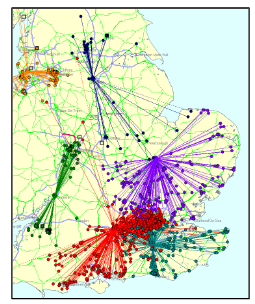
LPC were retained by DHL Tradeteam to review a wholesaler client’s fleet requirement and how distribution ought to change to maximise efficiency and minimise cost to serve.
The fleet was due for renewal and it was felt that its current size and profile was inadequate due to low fill rates driven by high delivery time restrictions.
Delivery windows were continually being missed despite the daily plan obeying all restrictions and appearing to be workable and correct at the time of issue. This incurred heavy penalties for missing OTIF targets.
The booked times and narrow delivery windows demanded by the wholesalers customers was adding considerable cost to the operation by inflating the resource requirement. It was felt that most of these delivery time demands could be relaxed in exchange of an advanced delivery time communication with Wholesaler’s customers. The Distributers wishes were to determine what the magnitude of savings could be if delivery time restrictions were to be relaxed in order to open discussions with the Wholesaler with a view to saving them money and improving OTIF scores.
Objectives
 Further to the above, LPC International has been requested to carry out the following pieces of work:
Further to the above, LPC International has been requested to carry out the following pieces of work:
- Review the outbase solution for the open book vehicle base.
- Determine the optimum fleet size and profile for the current service level requirements.
- Understand why the current performance does not match that predicted by the plan and is resulting in excessive missed delivery windows and OTIF targets.
- Check whether the current plans can be improved upon.
- Determine the potential saving that could be had through the relaxation booked delivery times.
The original proposal by LPC international was written to address objectives 1 and 2. However, it was clear to LPC International why current performance was not matching that predicted by route planning and strongly recommended that Objective 3 was addressed before 1 and 2, otherwise the solution will be optimistic and the current issue will remain. The following sections are written with this in mind.
Background
As the fleet replacement date approached for the Wholesaler Wines distribution operation, the Distributer retained LPC to assist them with the following:
- Determine the source and remedy for their increasing incidence of missed On-Time In-Full (OTIF) deliveries.
- Review of their distribution Network.
- Calculation of the size and profile of the replacement fleet.
Stock was held in Reading for direct delivery into Central and Greater London with regional deliveries carried out by the local Distributors outbases.
Methodology
 To assist or enable all elements of the study a base case model was built using historical delivery data of two average and two peak weeks. The model was built with all routes exactly as planned down to the route content, drop order and vehicle size using the same software Distributer use for daily planning.
To assist or enable all elements of the study a base case model was built using historical delivery data of two average and two peak weeks. The model was built with all routes exactly as planned down to the route content, drop order and vehicle size using the same software Distributer use for daily planning.
Missed OTIFs
The bulk of the missed OTIFs were in Central London where nearly half of customers have AM delivery restrictions. Reaching East London from Reading for an AM delivery is a challenge in its own right. To identify less obvious reasons for declining service standards, a sample of routes were compared as planned vs. as in the model vs. as driven on the day according to TMS data. This revealed that on average, speeds and unloading times were comparable between the original plans, the base case model and the
actual operation according to the TMS data. However, it was the exceptions that were causing the missed service levels:
- Most of the actual unloading times broadly matched the planned unloading times, but there were some unloading times that were much higher than planned and these had a knock on effect for the rest of the route.
- Broadly, most of the inter drop driving times approached the planned inter drop driving times but there were a number of exceptions, probably due to traffic jams, where the inter drop driving time was much higher than planned leading to missed OTIFs later in the trip.
- There were instances of risky planning where a delivery was planned to arrive ten minutes before the delivery window closed or an AM delivery was placed on the latter half of a trip, leading to a negative outcome.
- The default digitised road network lacked detail at the urban road level leading to nearly adjacent deliveries having other drops placed in between them on the plan.
- Drivers chose to change the delivery order of their routes in over a third of cases. One contributing factor to this behaviour is likely to be the lack of digital road network detail at urban level.
Given the findings, these were the recommendations put forth:
- In order to mitigate unexpected delays, introduce defensive planning such as:
- Changing AM customers’ delivery windows to close 30 minutes earlier in the customer master file.
- Avoiding the planning of AM deliveries in the second half of a route.
- Investigate instances where delivery took a lot longer than planned. If this is due to one or more customers’ consistent behaviour, then amend their record in the customer master file accordingly with longer delivery times.
- Replace the default digitised road map with a fully detailed one such as the ones used by satnavs to get a more rational drop order that drivers do not feel the need to alter.
- Set up a feedback loop between drivers and planners to introduce to and maintain in the planning software slow down factors for specific times of day and at known traffic black spots.
Replacement Fleet Size & Profile
Building a detailed base case model is essential to any transport modelling study. Not only does it prove or not that the data and parameters used are correct and representative, but if it is built exactly as planned as it was in this instance, the base case model immediately highlights what is thought to be but is not.
What was learned from the exact base case model was that many customers were restricted to vans in the master file not because they physically were but because they had habitually been planned to be served by vans. This became obvious when routes known to have been run with a 7.5T or 18T rigid were peppered with drops allegedly restricted to vans. Had this not been brought to light then fleet size and profile proposed would not have been correct.
After the issues highlighted by the base case were dealt with the four representative weeks’ data were rescheduled in order to determine the appropriate fleet size and profile to move forward with. Given the findings of the investigation into missed OTIFs, two solutions were put forth: one assuming no changes to operations and a second one assuming more defensive planning in order to meet OTIF targets.
Review Of Distribution Network
The main distribution network opportunity revolved around supporting the Reading stockholding site. Reaching East London from Reading is a challenge so a suitable Distributer site in East London was tested as a satellite. What came to light was that the benefits of adding such a location to the network were limited because the predominance of AM deliveries in its catchment area meant that driver average shift times were too short at the East London site and therefore the number of vehicles higher than should be given normal average drivers’ hours.
Whilst for this scenario there were savings to be had on radial delivery, the aggregated vehicle count between the two sites would have decrease and the utilisation of the Reading fleet would have increased, these savings were cancelled by the trunking requirement to feed the East London satellite, so the only benefit of this arrangement was in terms of increased customer service and reduced risk of missed OTIFs.


